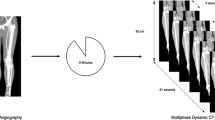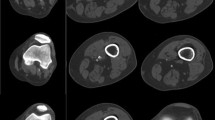Abstract
We evaluated 16-detector-row CT in the assessment of occlusive peripheral arterial disease (PAD) of the abdominal aorta and lower extremities using an adaptive method of acquisition to optimise arterial enhancement especially for the distal foot arteries. Thirty-four patients underwent transcatheter angiography (TCA) and CT angiography within 15 days. For each patient, table speed and rotation were selected according to the calculated optimal transit time of contrast material obtained after a single bolus test and two dynamic acquisitions at aorta and popliteal arteries. Analysis included image quality and detection of stenosis equal or greater than 50% on a patient basis and on an arterial segment basis. Sensitivity and specificity of CT were calculated with the TCA considered as the standard of reference. CT was conclusive in all segments with no technical failures even in difficult cases with occluded bypasses and aneurysms. On patient-basis analysis, the overall sensitivity and specificity to detect significant stenosis greater than 50% were both 100%. Segmental analysis shows high values of sensitivity and specificity ranging from 91 to 100% and from 81 to 100%, respectively, including distal pedal arteries. Sixteen-detector-row CT angiography using an adaptive acquisition improves the image quality and provides a reliable non-invasive technique to assess occlusive peripheral arterial disease, including distal foot arteries.








Similar content being viewed by others
References
Malden ES, Picus D, Vesely TM, Darcy MD, Hicks ME (1994) Peripheral vascular disease: evaluation with stepping dsa and conventional screen-film angiography. Radiology 191:149–153
Rubin GD, Zarins CK (1995) MR and spiral/helical CT imaging of lower extremity occlusive disease. Surg Clin North Am 75:607–619
Reimer P, Landwehr P (1998) Non-invasive vascular imaging of peripheral vessels. Eur Radiol 8:858–872
Fleischmann D, Rubin GD (2005) Quantification of intravenously administered contrast medium transit through the peripheral arteries: implications for CT angiography. Radiology 236:1076–1082
Qanadli SD, Chiappori V, Kelekis A (2004) Multislice computed tomography of peripheral arterial disease: new approach to optimize vascular opacification with 16-row platform. Eur Radiol 14(Suppl 2):b806
Rieker O, Duber C, Neufang A, Pitton M, Schweden F, Thelen M (1997) CT angiography versus intraarterial digital subtraction angiography for assessment of aortoiliac occlusive disease. AJR Am J Roentgenol 169:1133–1138
Lawrence JA, Kim D, Kent KC, Stehling MK, Rosen MP, Raptopoulos V (1995) Lower extremity spiral CT angiography versus catheter angiography. Radiology 194:903–908
Ho KY, Leiner T, de Haan MW, Kessels AG, Kitslaar PJ, Van Engelshoven JM (1998) Peripheral vascular tree stenoses: Eevaluation with moving-bed infusion-tracking MR angiography. Radiology 206:683–692
Ofer A, Nitecki SS, Linn S, Epelman M, Fischer D, Karram T, Litmanovich D, Schwartz H, Hoffman A, Engel A (2003) Multidetector CT angiography of peripheral vascular disease: A prospective comparison with intraarterial digital subtraction angiography. AJR Am J Roentgenol 180:719–724
Landis JR, Koch GG (1977) An application of hierarchical kappa-type statistics in the assessment of majority agreement among multiple observers. Biometrics 33:363–374
Rubin GD, Schmidt AJ, Logan LJ, Sofilos MC (2001) Multi-detector row CT angiography of lower extremity arterial inflow and runoff: initial experience. Radiology 221:146–158
Fleischmann D, Hallett RL, Rubin GD (2006) CT angiography of peripheral arterial disease. J Vasc Interv Radiol 17:3–26
Martin ML, Tay KH, Flak B, Fry PD, Doyle DL, Taylor DC, Hsiang YN, Machan LS (2003) Multidetector CT angiography of the aortoiliac system and lower extremities: a prospective comparison with digital subtraction angiography. AJR Am J Roentgenol 180:1085–1091
Ota H, Takase K, Igarashi K, Chiba Y, Haga K, Saito H, Takahashi S (2004) MDCT compared with digital subtraction angiography for assessment of lower extremity arterial occlusive disease: importance of reviewing cross-sectional images. AJR Am J Roentgenol 182:201–209
Catalano C, Fraioli F, Laghi A, Napoli A, Bezzi M, Pediconi F, Danti M, Nofroni I, Passariello R (2004) infrarenal aortic and lower-extremity arterial disease: diagnostic performance of multi-detector row CT angiography. Radiology 231:555–563
Rubin GD, Shiau MC, Schmidt AJ, Fleischmann D, Logan L, Leung AN, Jeffrey RB, Napel S (1999) Computed tomographic angiography: historical perspective and new state-of-the-art using multi detector-row helical computed tomography. J Comput Assist Tomogr 23(Suppl 1):s83–s90
Fraioli F, Catalano C, Napoli A, Francone M, Venditti F, Danti M, Pediconi F, Passariello R (2006) Low-dose multidetector-row CT angiography of the infra-renal aorta and lower extremity vessels: image quality and diagnostic accuracy in comparison with standard DSA. Eur Radiol 16:137–146
Wintersperger B, Jakobs T, Herzog P, Schaller S, Nikolaou K, Suess C, Weber C, Reiser M, Becker C (2005) Aorto-iliac multidetector-row CT angiography with low kV settings: improved vessel enhancement and simultaneous reduction of radiation dose. Eur radiol 15:334–341
Willmann JK, Baumert B, Schertler T, Wildermuth S, Pfammatter T, Verdun FR, Seifert B, Marincek B, Bohm T (2005) Aortoiliac and lower extremity arteries assessed with 16-detector row CT angiography: prospective comparison with digital subtraction angiography. Radiology 236:1083–1093
Ouwendijk R, Kock Mc, Van Dijk LC, Van Sambeek MR, Stijnen T, Hunink MG (2006) vessel wall calcifications at multi-detector row CT angiography in patients with peripheral arterial disease: effect on clinical utility and clinical predictors. Radiology 241:603–608
Raptopoulos V, Rosen MP, Kent KC, Kuestner LM, Sheiman RG, Pearlman JD (1996) Sequential helical CT angiography of aortoiliac disease. AJR Am J Roentgenol 166:1347–1354
Rofsky NM, Adelman MA (2000) MR angiography in the evaluation of atherosclerotic peripheral vascular disease. Radiology 214:325–338
Author information
Authors and Affiliations
Corresponding author
Rights and permissions
About this article
Cite this article
Laswed, T., Rizzo, E., Guntern, D. et al. Assessment of occlusive arterial disease of abdominal aorta and lower extremities arteries: value of multidetector CT angiography using an adaptive acquisition method. Eur Radiol 18, 263–272 (2008). https://doi.org/10.1007/s00330-007-0749-0
Received:
Revised:
Accepted:
Published:
Issue Date:
DOI: https://doi.org/10.1007/s00330-007-0749-0




